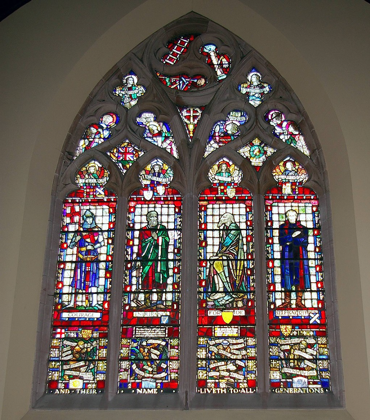Our Heritage Timeline
Labour Corps WW1 National Memorial Window

Labour Corps WW1 National Memorial Window
How did an outstanding National War Memorial come to be in Blairgowrie and Rattray?
In Blairgowrie and Rattray there is a unique and powerfully poignant memorial dedicated to members of a very special British Army unit who gave their lives during WW 1.
On the Rattray side of the River Ericht, at the junction of Boat Brae and Riverside Road, stands the magnificent, red sandstone former Riverside Methodist Church.
Much of the church interior has been changed. The pews and organ have been removed, but a unique and very special jewel remains. The Labour Corps Memorial Window has been restored and preserved for posterity.
The Labour Corps was a British Army unit formed in 1917 to provide manpower to support the troops on the front line during World War 1 by carrying out what could be termed labour work. Men who were experienced with picks and shovels e.g. miners and road men, as well as those who had skilled trades e.g. smiths,carpenters, joiners, bricklayers, masons, engine drivers and fitters were required in the Labour Corps.
Although these men were graded medically unfit for fighting, they were trained to be capable of fighting as infantry. Men of the Labour Corps were posted to the front to carry out work such as building roads and railways, digging latrines, carrying the wounded and burying the dead. They worked hard to support and care for soldiers on the front line, often making the ultimate sacrifice. Their contribution to the war effort is rarely acknowledged.
Early in 1917 Blairgowrie became the Headquarters of the Labour Corps. Between 3000 and 4000 men would be stationed in Blairgowrie at any one time. They would arrive by train and were billeted at the Haugh. They were a common sight in the streets of Blairgowrie and Rattray and the people of the town provided support.
They were made to feel particularly welcome at the Riverside Methodist Church, where two years earlier in October 1915 a party of soldiers had pulled up outside the Church. Tea was provided for them by Church members and that was when the idea of having a Soldiers Club was born. Over the next couple of years, soldiers were provided with writing materials, table games, magazines and a piano. Light meals would be served at less than 3d a meal.
The Church continued to be a haven for the Labour Corps soldiers and it is said that as many as 500 men might visit the Church each night. Even if they arrived at Blairgowrie Station in the middle of the night, they could be sure of a welcome and some food at the Church. Around 20000 men of the Labour Corps of all ranks passed through Blairgowrie between 1917 and 1919. Over 7000 Officers, Non-commissioned Officers and men of the Labour Corps were killed, or died of wounds or sickness during World War I.
In 1919 a Memorial Fund was started by Officers and men and the decision was taken that the Memorial should be in the form of a stained glass window in the Riverside Methodist Church The unveiling ceremony was held on Saturday 2nd December 1922 and the Dedication reads: To the Glory of God and in memory of the officers, non-commissioned officers and men of His Majesty’s forces who gave their lives while serving in the Labour Corps in the Great War, 1914 – 1918.
For a full description of the Labour Corps WWI National War Memorial Window visit https://www.warmemorialsonline.org.uk/memorial/153496
https://canmore.org.uk/site/162159/rattray-boat-brae-riverside-methodist-church
The Church was sold in 2015 and converted to a restaurant in 2018 - see A Little Revival - a short documentary film by Patrick Rooney (Dear Friend Films)
Previous Page
